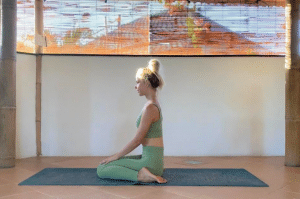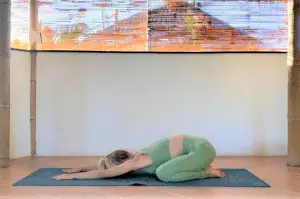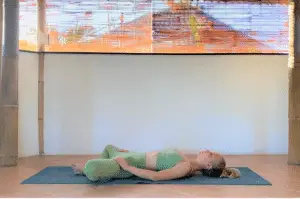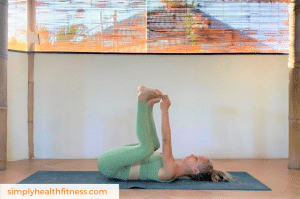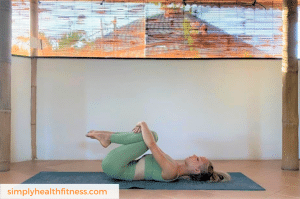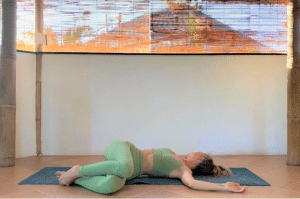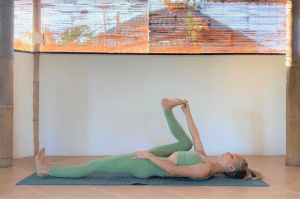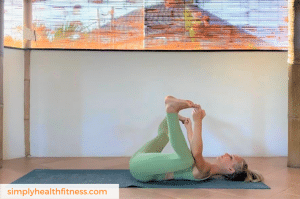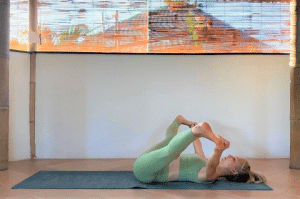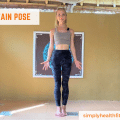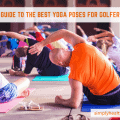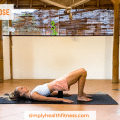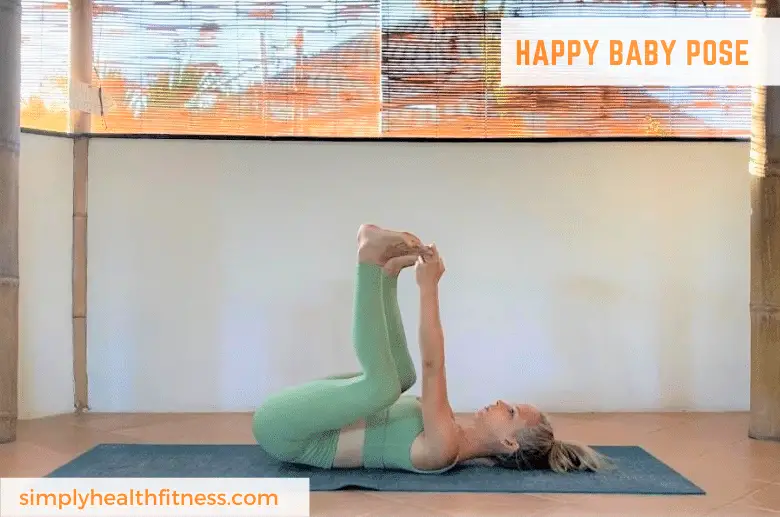
The happy baby pose in yoga, also sometimes known as the “dead bug pose” is used as a soothing hip opener in both yoga and pilates.
In Sanskrit, it is called “Ananda Balasana” where “ananda” means “happy” “bal” means child/baby, and “asana” means posture.
As the name suggests, the position has a calming effect as you lie on your back and ease hip and spinal tension. It is typically done in the beginning or end of the practice because of its restful nature.
This asana is beginner-friendly and very simple, but knowing how to do the happy baby properly will offer a range of physical benefits.
[lwptoc hideItems=”1″]
Step by Step Guide On How To Do Happy Baby Pose
Preparatory Poses
Before you begin, it is important to warm up your joints and muscles involved to prevent injury and maximise the exercise.
Hero Pose (Virasana)
This pose is good to do before happy baby, especially if you have naturally stiff knees, to warm up your joints and prevent unnecessary tension. Get into a kneeling position and take your ankles at hip distance, so that your glutes lower to the floor. Spread your calf muscles so they are beside your thighs rather than under them. An option is to place a block under your glutes if your knees are too tight. With a long spine, breathe here for 10 breaths.
Child’s Pose (Balasana)
The child’s pose will encourage length in your spine and will soften your hip joint. From table top, bring your feet together and knees apart as you shift back to sit on your heels. Reach your arms forward and rest your forehead to the floor to lengthen your spine and relax your neck. Rest here for 5-10 deep breaths.
Supine Butterfly Pose (Supta Badhakonasana)
Doing the butterfly on your spine instead of seated will give you the spinal sensation you want for spinal neutrality. This is also an intense hip and inner groin stretch, so it will ensure more open and warm hips. To enter, start on your back and make sure your entire back, shoulders, and head are resting on the floor. Bring the soles of your feet together, as close as you can to your groin, and breath deeply for 5-10 breaths.
Happy Baby Pose (Ananda Balasana)
- Start by lying on your back on a yoga mat or folded blanket.
- With your knees bent, hug them into your chest and spread them as wide as your torso.
- With your knees wide, grab your big toes with your peace fingers or use a yoga strap, and raise your feet directly to the sky.
- Make sure your tailbone and shoulders remain on the mat so that your entire back is grounded.
- Deepen the hip stretch and pull your feet with your hands to draw your knees closer to your armpits.
- Inhale and exhale deeply 5-10 times.
Counter Poses
Counter stretches allow the muscles and joints to release tension to prevent stiffness, injuries, and pain post-workout.
Knees to Chest Pose
Lie on your back and hug your knees together into your chest. This pose will release the intense hip and inner groin stretch in a safe and soothing way. You can even draw circles with your knees here if you have tight hips and inner thighs. Stay here for 5-10 breaths.
Supine Twist
With bent knees, take them over to one side and keep your spine and shoulders on the floor. Look to the opposite side and spread your arms out in a capital T or cactus position. The happy baby pose is almost always added to the end of any yoga practice, as gives the spinal joints a final release after all the work that’s been done. Take 5-10 deep breaths on each side.
Joints and Muscles Involved in the Happy Baby Pose
Hips: The hip muscles and joints play a large part in maintaining our stability and posture. This joint connects our upper body to our lower body, making it imperative to keep healthy for full-body balance. Releasing tension and stiffness in this area will provide more hip mobility needed in day-to-day activities.
Hip Adductors (Inner Thighs): This particular yoga position gives an intense inner thigh stretch, which is especially useful in maintaining proper form during walking, yoga, and other forms of exercise. Strong muscles can have a negative effect if they are short and inflexible, as they will inhibit range of movement. Stiffness in this area will cause other parts of the body to compensate and, therefore, cause pain and improper alignment.
Back Muscles: The muscles that support our spine and core are also important for our posture and stability in everyday life. Weak and/or stiff back muscles plague the lower back and cause headaches and fatigue. Happy baby can help elongate the spine to relieve tension in the low back, shoulders, and neck.
Variations of the Happy Baby Pose
In all yoga positions, there are always variations you can experiment with to intensify or deepen the stretch. Yoga is a practice that doesn’t discriminate against what shape, size, or age you are so that it can be adaptable to all body types. Therefore, with these variations, you can cater to what your body needs and/or is more comfortable with.
One leg at a time: Whether balancing on the spine is tricky for you, or if you want to focus on one hip at a time, you can straighten one leg on the floor and bend the other. Make sure you do each side equally – you might find that one side is stiffer than the other!
Spread your feet: To stretch the inside of your thighs more, you can straighten one leg at a time, or even both (if you can balance). This stretch focuses more on the inner groins, so make sure that you are warm enough!
Rock side to side: Gently rock side to side like an actual baby would do on his/her back. This variation gives a massage to your back muscles surrounding the spine and the tailbone, which can be very soothing as well.
Beginner’s Tips
- Accept that you are a beginner and allow your body the time to get used to these new positions. If you push too hard too soon, you will hurt yourself!
- Take the adjustments and variations offered above in order to make it more comfortable and optimize its positive effects.
- If balancing on your spine proves challenging, take your knees to chest asana first.
- Have a yoga mat or rolled blanket to comfort the spine and/or back of the head.
Key Physical Benefits
Hip Opening
The happy baby asana improves our hip mobility, which has effects that go beyond supplementing our active lifestyles. Stretching the inside of our thighs and hip flexors will benefit our range of motion in walking, running, cycling, gym training, etc., and impacts our posture in daily life. Sitting long hours and/or being emotionally stressed can result in tight hips, which can cause slouching and overarching in the tailbone. It can also ease cramps and lower back pain from menstruation because it soothes the abdomen, sacral, and lower back areas.
Spine Neutrality
The focus on elongating the spine from the supine position (lying on your back), will promote spine neutrality. Lengthening and strengthening the spine will impact our posture in how we sit, walk and do exercise. The supine position also promotes natural spinal curves by counteracting extreme arching in the tailbone and/or upper back.
Balance and Flexibility
Asanas like this one also help to increase your balance, which gives us more stability in our form and posture. Increased balance helps prevent ankle or knee injury because the joints are more stable. Stability in the knees and ankles also reduces the risk of falling, which increases as we age. Furthermore, the flexibility we gain in this position will also prevent our body from putting tension in other joints and muscles.
Common Mistakes and Risks
- Do not let your shoulders, lower back, or head come off the mat.
- Refrain from reaching too far, as it can cause strain and neck injury.
- Avoid injury by stopping if there is any pain in your joints or muscles.
- It is not recommended to do this particular pose in the first trimester of pregnancy.
- Consult with a professional if you have an injury or are recovering from surgery.
FAQ
How long should you hold Happy Baby pose?
Depending on the type of yoga that you are doing, the length of holding this pose can differ. If you are doing yin yoga, asanas are held for 3-5 minutes because the focus is more on getting a gentle stretch by not actively pushing the poses. In the case of a more strenuous type of yoga, such as vinyasa or power yoga, this asana will be more of an active stretch and, therefore, will be held for 5-10 breaths. If your goal is to relax and calm your breath, then do it the yin yoga way. However, if you want an active stretch, then happy baby can only be held for a few breaths.
How can I get better at Happy Baby pose?
There is no “getting better” at asanas, but rather making the most of them as you improve in strength and flexibility. The best way to introduce yourself to a new position is to take the beginner variations and use props to help you get the correct alignment and feel the correct places working. For this asana, doing preparatory stretches to warm some key areas, like the ones found above, will help you a lot.
Is Happy Baby pose good for lower back pain?
Yes! Lower back pain can come from poor posture, sitting for too long, strenuous exercise, menstrual cramping, etc. Whenever you feel discomfort in this area, it is good to take a restful pose like happy baby pose. Increase your lower back comfort by rocking from side to side and giving your muscles a massage.
Final Thoughts
While it looks simple, incorporating happy baby pose can be extremely beneficial, no matter if we are regular yoga go-ers, cardio-enthusiasts, or weight lifters (or none of the above!).
With the focus on opening up the hips while being on our backs, we can increase mobility, improve posture, prevent injuries, and ease lower back pains.
With the many variations, you can do for the happy baby pose, you can make either make it more soothing or active depending on what your body needs.
Finally, it is vital that you take this pose slow, follow the instructions, and make the adjustments needed in order to maximize all the great benefits.
